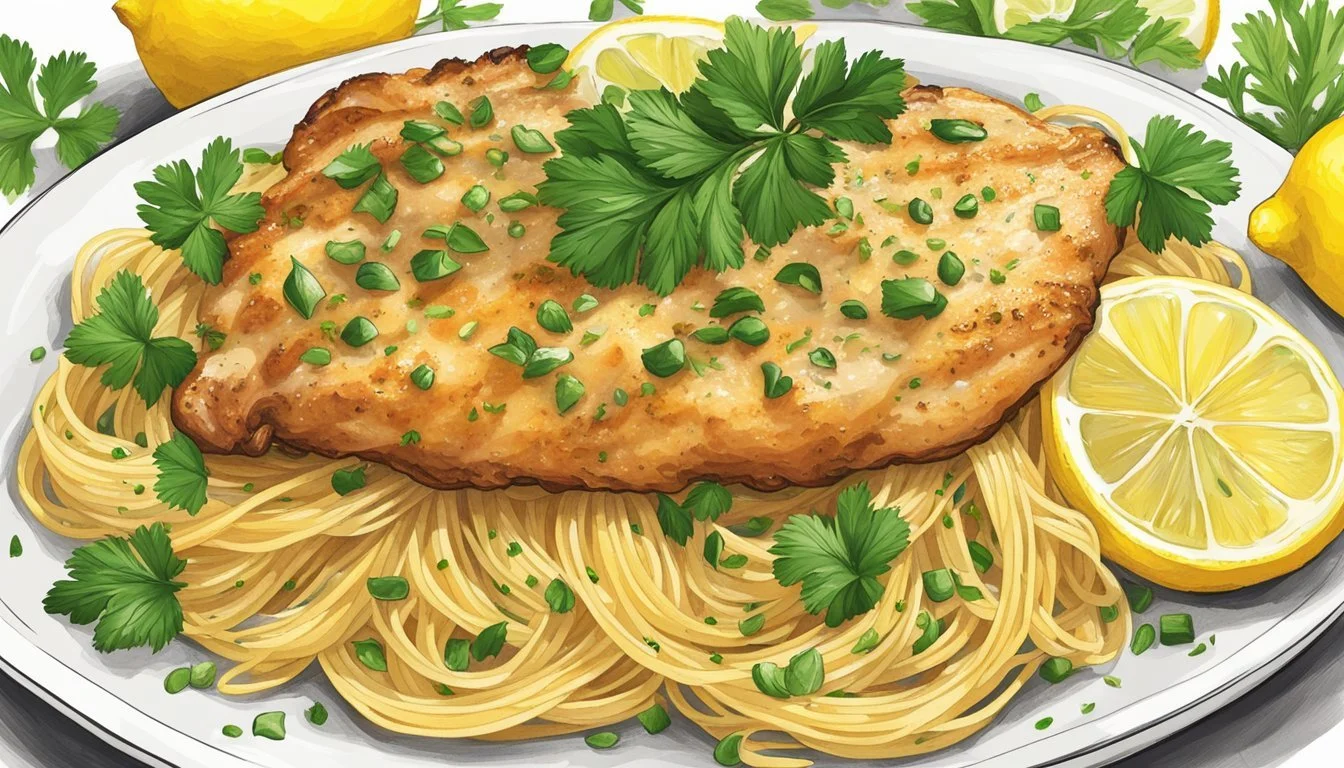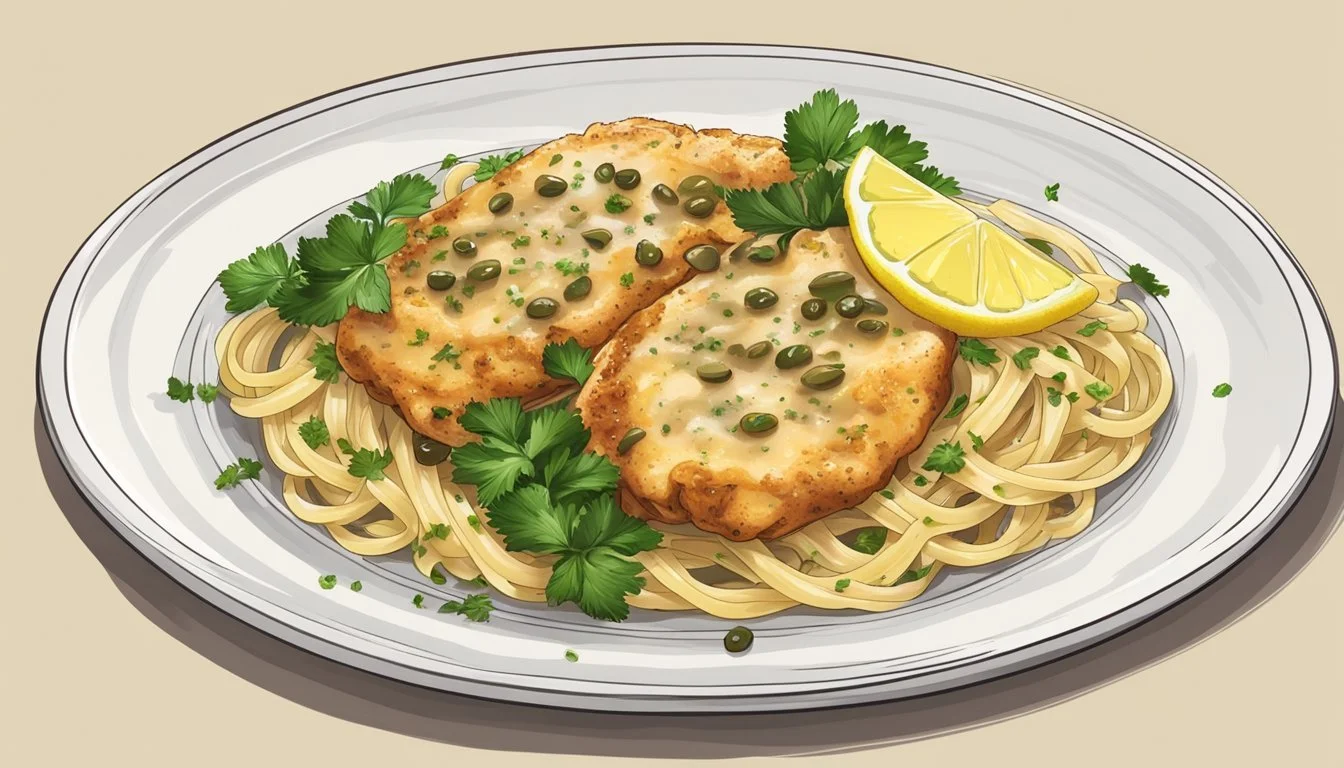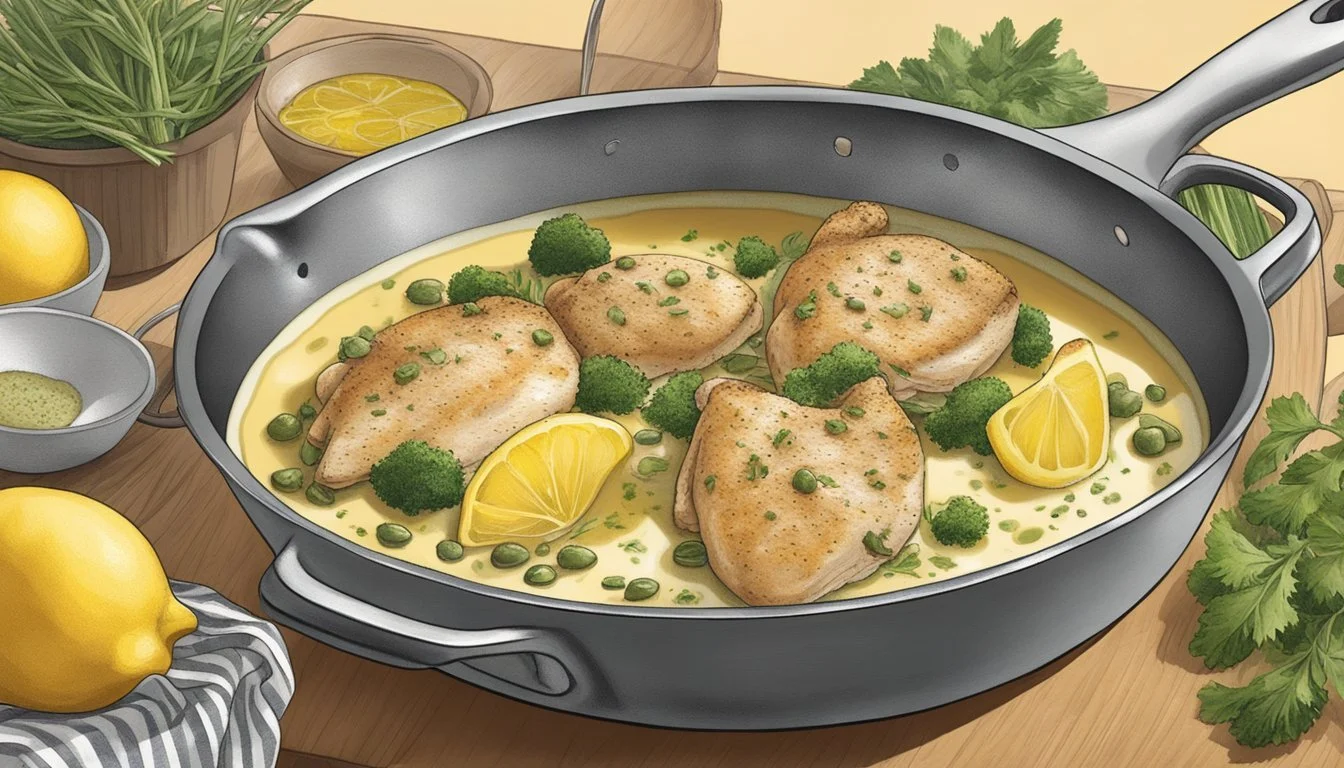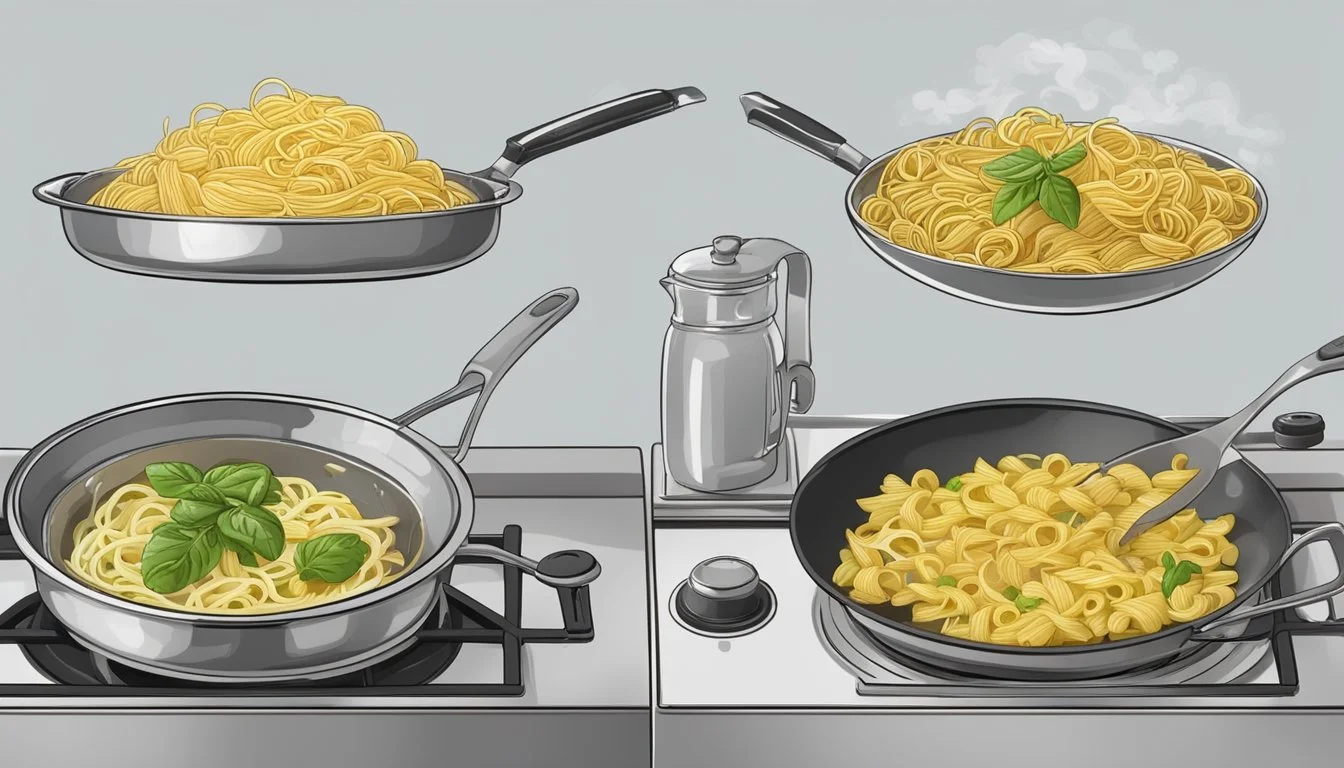How Long Does Chicken Piccata with Pasta Last?
Storage Tips and Shelf Life
Chicken piccata with pasta is an Italian classic that effortlessly combines tender chicken breasts with a zesty lemon-caper sauce served over a bed of pasta. This flavorful dish is not only easy to prepare but also a favorite for family dinners, making it perfect for busy weeknights. The dish can last up to three to four days in the refrigerator when stored properly in an airtight container.
Ensuring that chicken piccata remains fresh involves proper storage and handling. After cooking, it's essential to let the dish cool before transferring it to an airtight container. Refrigerating promptly can mitigate the growth of bacteria, keeping the dish delicious and safe for later consumption.
For those who love meal prepping or plan to enjoy leftovers, chicken piccata with pasta can also be frozen for longer preservation. By placing it in a freezer-safe container, you can extend its life for up to three months. When ready to eat, thaw in the refrigerator overnight and reheat thoroughly to savor that vibrant, tangy flavor.
Overview of Chicken Piccata with Pasta
Chicken Piccata with Pasta is a classic Italian-American dish that features tender chicken breasts in a light, tangy sauce. The main ingredients commonly include all-purpose flour, butter, lemon juice, capers, and garlic. The chicken is typically dredged in flour and sautéed in olive oil until golden brown.
After the chicken is removed from the pan, a sauce is made using butter, lemon juice, capers, and occasionally white wine. This sauce is poured over the chicken. Fresh parsley is often sprinkled on top for added flavor and presentation.
The dish is usually served over a bed of pasta. The pasta is cooked in salted water until al dente and can be any variety, but long noodles like spaghetti or linguine are commonly used. The lemony sauce from the chicken complements the pasta perfectly, making it a flavorful and satisfying meal.
Many versions of Chicken Piccata also include additional ingredients like mushrooms or tomatoes, which can be added to the sauce for extra depth of flavor. The dish balances acidity from the lemon, brininess from the capers, and richness from the butter, creating a harmonious combination of tastes.
Essential Ingredients
Chicken Piccata with Pasta relies on simple yet flavorful components to create a delightful dish. Key elements include proteins like chicken breasts, fats such as butter and olive oil, as well as herbs and other flavorings. Various pasta types complement the dish beautifully.
Proteins and Fats
Chicken breasts are the primary protein, providing a tender and juicy base. It's recommended to use boneless, skinless chicken breasts for ease of preparation and better texture. Cooking the chicken properly ensures it remains moist and flavorful.
Both salted and unsalted butter are used in the dish. Butter adds richness and helps in creating a creamy sauce. When combined with olive oil—preferably extra virgin olive oil for its superior taste and quality—the fats blend seamlessly to enhance the dish's overall richness.
Herbs and Flavorings
In Chicken Piccata, simple yet effective flavorings make a significant impact. Fresh garlic and shallots are sautéed to release their aromas, adding depth to the flavor profile. Capers and lemon juice introduce a zesty, tangy note that balances out the richness of the butter and olive oil combination.
It's essential to use freshly squeezed lemon juice for its bright, fresh flavor. Additionally, chicken broth can be included to add a savory base to the sauce. Herbs like parsley provide a fresh, green element, making the dish feel well-rounded.
Pasta Varieties
The type of pasta used can vary. Spaghetti is a popular choice, offering a classic look and texture. Penne, with its ridged surface, holds onto the sauce well, making each bite flavorful. Linguine and fettuccine are also excellent options, providing a slightly broader noodle for those who prefer that texture.
For a more delicate presentation, angel hair pasta can be used. Its fine strands cook quickly and carry the sauce lightly. Each pasta variety brings its own unique texture and complementary element to the Chicken Piccata, allowing for personalization based on preference.
Preparing the Chicken
Preparing the chicken for chicken piccata with pasta involves several essential steps. These include flattening and flouring the chicken breasts, cooking them to the right temperature, and ensuring they have a golden-brown crust.
Flattening and Flouring
Begin by using boneless, skinless chicken breasts. Place each breast between two sheets of plastic wrap. Use a meat mallet to pound the chicken to an even thickness of about 1/2 inch. This ensures even cooking and tenderness. Remove the chicken from the wrap and season with kosher salt and freshly ground black pepper.
Next, prepare a plate with all-purpose flour. Dredge each chicken breast in the flour, shaking off any excess. This step is crucial for creating a light coating that will brown beautifully in the pan and help thicken the sauce later. Ensure all sides of the chicken are evenly coated before moving on to cooking.
Cooking to the Right Temperature
Heat a skillet over medium-high heat and add a mixture of olive oil and butter. Once the butter has melted and the oil is shimmering, place the floured chicken breasts in the skillet. Cook the chicken for about 3-4 minutes per side.
The goal is to reach an internal temperature of 165°F (74°C). Use a meat thermometer to check the temperature to avoid overcooking. Proper cooking ensures the chicken remains juicy and flavorful. Remove the chicken from the skillet and set it aside on a plate when it is done, covering it lightly with foil to keep warm.
Achieving a Golden Brown Crust
Achieving a golden-brown crust on the chicken is essential for both texture and flavor. The combination of olive oil and butter helps in browning. Do not overcrowd the pan, as this will steam the chicken instead of searing it. Cook the chicken in batches if necessary.
Resist the urge to move the chicken around in the pan too much. Let each side cook undisturbed for the full 3-4 minutes. This allows for a deep golden crust to form. Once browned, the chicken will not only look appealing but will also have a delightful crispness that complements the tender interior.
Creating the Piccata Sauce
To create a perfect piccata sauce, balance tangy lemon flavors with savory components. The key elements include capers, lemon juice, and a mixture of chicken stock and white wine.
Incorporating Capers and Lemon
Capers add a tangy, salty element to the sauce. Begin by draining and rinsing capers to remove excess salt. Add them to the pan with butter over medium heat. The butter will melt and blend with the capers, creating a foundational flavor.
Next, add freshly squeezed lemon juice and lemon zest. This combination provides the signature tanginess of the sauce. Using both juice and zest ensures a robust lemon flavor. If desired, incorporate a bit of dry white wine to enhance depth.
Adjusting Consistency and Flavor
To achieve the right consistency, mix chicken broth or chicken stock with a thickening agent such as a small amount of cornstarch dissolved in water. Slowly stir this mixture into the pan, allowing it to thicken.
Taste and adjust the seasoning with salt and pepper as needed. Adding a small amount of heavy cream can offer a richer texture and milder taste. Let the sauce simmer for several minutes until it reaches the desired thickness and all flavors are well combined.
Finishing Touches with Fresh Ingredients
For the final touch, finely chop shallots and sauté them in the butter before adding other ingredients. This provides a mild, sweet onion flavor that complements the tartness of the lemon.
Add fresh herbs like parsley at the end for a burst of color and freshness. A sprinkle of extra lemon zest over the finished chicken piccata can also enhance its visual appeal and taste.
Cooking and Pairing the Pasta
Properly preparing the pasta and choosing the right type are essential steps for enhancing the flavors of chicken piccata. Additionally, selecting complementary side dishes can create a balanced and delightful meal.
Boiling Pasta to Al Dente
Cooking pasta to al dente is crucial. This translates to "to the tooth," meaning the pasta should be firm when bitten. To achieve this:
Fill a large pot with water, adding a tablespoon of salt for every 4-5 quarts.
Bring the water to a rolling boil.
Add the pasta, stirring occasionally to prevent sticking.
Typical cooking times for different pastas are:
Spaghetti Noodles: 10-12 minutes
Whole Wheat Pasta: 12-14 minutes
Gluten-Free Pasta: 8-10 minutes
After cooking, reserve some pasta water to enhance the sauce.
Choosing the Right Pasta for the Sauce
The sauce used in chicken piccata is rich with flavors from lemon juice, capers, and chicken broth. Picking the right pasta ensures the sauce adheres well. Recommended types include:
Pappardelle: With its broad and flat shape, it distributes the sauce evenly.
Spaghetti Noodles: Their long strands effectively soak up the sauce.
Gluten-Free Pasta: Ensures inclusivity for those with dietary restrictions.
Avoid delicate or overly thin pastas, as they may not support the robust sauce. Whole wheat pasta can also be a healthier option that pairs nicely with the dish's flavors.
Complementary Side Dishes
To accompany chicken piccata with pasta, consider adding lighter side dishes to balance out the meal:
Roasted Vegetables: Options like spinach, mushrooms, and bell peppers complement the dish well.
Salad: A fresh green salad with a light vinaigrette can add a crisp contrast.
Vegetable Medleys: Steamed or grilled veggies can provide a colorful and nutritious side.
These sides contribute to a balanced pasta dinner, enhancing both flavors and nutrition without overpowering the main dish.
Storing Leftovers
Properly storing leftover chicken piccata with pasta ensures it remains safe to eat and retains its flavor and texture.
Refrigeration and Container Guidelines
Leftover chicken piccata should be placed in an airtight container to prevent the absorption of other fridge odors and to maintain its moisture. It is crucial to refrigerate leftovers within 2 hours of cooking to minimize the risk of bacterial growth.
The ideal shelf life for stored chicken piccata is 3-4 days. Make sure the refrigerator is set to a temperature of 40°F (4°C) or lower to keep the food safe. Consuming the dish within this timeframe ensures the best flavor and texture retention.
Reheating for Best Quality
For the best quality, reheat chicken piccata on the stove or in the oven. Avoid using a microwave as it can unevenly heat the food. If using the stove, add a little broth or water to prevent the chicken from drying out. Reheat on medium heat until thoroughly warmed.
Alternatively, if using an oven, preheat to 350°F (175°C) and cook for 10-15 minutes. Again, adding a bit of liquid can help maintain moisture. Stirring halfway through ensures even heating and better texture.
Serving Suggestions
When serving Chicken Piccata with pasta, attention to detail can elevate the entire dining experience. A well-presented dish with the right garnish enhances both the visual appeal and taste.
Presentation Tips
Arrange the Plate Thoughtfully: Place the chicken piccata pieces centrally on the plate. Surround the chicken with a neat nest of pasta. The sauce should be drizzled carefully over both the chicken and the pasta.
Use Appropriate Dishware: Use wide, flat plates to allow adequate space for arrangement. White plates can help the vibrant colors of the dish stand out.
Balance Colors: Incorporate bright, fresh parsley scattered across the dish. The green adds a pop that contrasts well with the golden brown chicken and yellow hues from the lemon slices.
Avoid Clutter: Ensure that the plate is not overcrowded. Space the components of the dish thoughtfully to give a clean and sophisticated look.
Garnish and Final Touches
Chopped Parsley: Sprinkle freshly chopped parsley over the top for both flavor and visual appeal. It should be added just before serving to retain its vibrant color.
Parmesan Cheese: Use shaved parmesan for an added rich, nutty flavor. Shavings can be placed over the pasta lightly for an elegant touch. Variations of parmesan cheese can also be considered depending on preference.
Lemon Slices: Thin lemon slices can be arranged around the dish or placed on the edge of the plate. They offer a zesty kick that complements the sauce.
Final Touch: Finish with a light drizzle of extra virgin olive oil and a crack of black pepper to enhance the delicious flavors. These simple touches ensure the dish not only tastes great but also looks restaurant-quality.
Nutrition and Dietary Considerations
Chicken Piccata with pasta offers a mix of protein and carbohydrates, accompanied by various vitamins and minerals. It is important to adjust the recipe to meet dietary needs, especially for those requiring low sodium or gluten-free options.
Caloric and Macro-nutrient Breakdown
Chicken Piccata with pasta is a well-balanced meal in terms of macronutrients. A typical serving provides a substantial amount of protein from the chicken. This protein is essential for muscle repair and growth.
Carbohydrates mainly come from the pasta. Different types of pasta may affect the nutritional content, but generally, they supply necessary energy. Many recipes add a creamy sauce made with butter and cream, contributing to the fat content.
Example Breakdown:
Calories: 400-600 kcal per serving.
Protein: 20-30 grams.
Carbohydrates: 45-60 grams.
Fats: 15-25 grams.
Fibre: Varies based on pasta type (whole wheat provides more).
Including vegetables like spinach or broccoli can add fiber and additional vitamins, making the dish more nutritious.
Adapting for Dietary Restrictions
For individuals with dietary restrictions, modifications can be made to Chicken Piccata with pasta.
Gluten-Free: Use gluten-free pasta options, such as those made from rice, corn, or quinoa. Ensure all ingredients, including the flour for dredging the chicken, are gluten-free.
Low Sodium: To reduce sodium intake, use low-sodium broth and limit added salt. Capers, while flavorful, are high in sodium and should be used sparingly.
Dairy-Free: Substitute the butter and cream typically used in the sauce with dairy-free alternatives like olive oil and coconut cream. These changes maintain the dish's creamy texture while catering to lactose intolerance or dairy allergies.
Adjusting the recipe to individual dietary needs ensures that everyone can enjoy this comfort food without compromising their health or dietary restrictions.
Recipes and Variations
Chicken Piccata with Pasta is a versatile meal that can be prepared in various ways. Below are details on how to make this classic dish and some creative twists on the traditional recipe.
Classic Chicken Piccata Recipe
To make a traditional Chicken Piccata, thinly sliced chicken breasts are typically used. Start by seasoning the chicken with salt and pepper, then dredge it in flour. Cook the chicken in a skillet over medium-high heat, using a combination of olive oil and butter. Sear each side for about 3-4 minutes until golden brown.
After cooking the chicken, set it aside and use the same pan to prepare the sauce. Add minced garlic, chicken broth, lemon juice, and capers. Let the sauce simmer until it thickens slightly. Return the cooked chicken to the skillet and coat it with the sauce. Serve over a bed of pasta, garnished with fresh parsley and lemon slices.
Creative Twists on the Traditional Dish
For a creative twist, breadcrumbs and garlic powder can be added to the flour mixture for extra texture and flavor. Another variation is to incorporate rosemary into the sauce. Melt additional butter in the pan, and fry garlic and shallots, then add white wine and let it reduce before adding the broth and lemon juice.
Consider adding vegetables like artichoke hearts or spinach for extra nutrition and flavor. For a dairy-free option, replace the butter with olive oil and use vegetable broth instead of chicken broth. Use gluten-free flour for dredging if required.
These variations allow for flexibility in preparation while maintaining the essential aspects of Chicken Piccata, enhancing both flavor and nutritional value.









